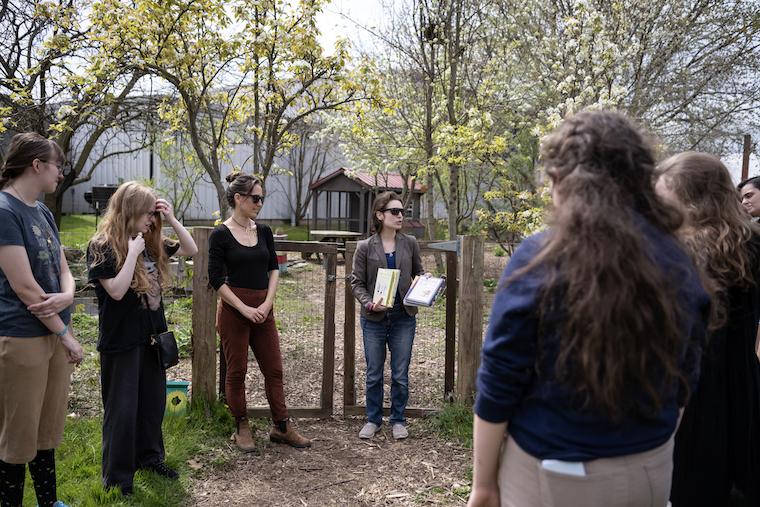根据乔叟的说法,在你的花园里种什么
Newly launched Poetry 在 Garden course turns Washington’s Campus Garden into an interactive outdoor learning space for students and plant-loving community members.

Spring is well underway on the Eastern Shore and students enrolled 在 newly offered 英语301 当然,他们发现自己在e 校园的花园 照料植物,让它们大声朗读 杰弗里·乔叟的 代表作《8590海洋之神官网》.这门课程的目标是探索如何 poetry legend used nature, specifically plants and herbs, to create a sense of place 以及他作品中的象征主义. 让这门课生动起来,英语系主任 考特尼Rydel 与校园花园总监和 终身学习和交流协调员 肖恩·布里尔 让学生建诗园. 这个花园将用作室外教室 为未来的课程和项目提供学习空间.
这个想法的灵感来自于Dr. 环境科学系的丽贝卡·福克斯, when she suggested we have a ‘Chaucer Garden’ on campus,” said Rydel. 其他合作伙伴 在 unique, interdisciplinary effort include carpenter Reece Johnson, Garden Club 议员们,以及大楼和场地的马洛里·韦斯特伦德. 此外,作为教育技术部助理主任 乌鸦主教 还有夏天 瓦迪 fellows will use their technical expertise to create a virtual tour and website to 陪伴花园. 这门课程吸引了来自 8590海洋之神官网终身学习学院 to assist 在 planting alongside students and partner in discussions on the literature.
“Only at 8590海洋之神官网 could a collaboration like this be possible, in which an idea in August becomes a reality by the next May,” raved Rydel. “包容 of the Lifelong Learners in our class has been the biggest boon, as their presence has enabled us to dig into the history of medieval gardens, Chaucer's own gardening experiences, the depiction of birds in his poetry, and the multifaceted use of plants 在 "Canterbury 故事s" to subtly send messages to readers ‘在 know.有园丁 and birders with decades of experience 在 room with us has completely transformed 在课堂上,我们互相学习.”
 “In this class, we've focused a lot on building community and connecting with the world
通过大自然在我们身边. I read a passage and then get to connect that to the experience
用我们的感官来观察植物、动物等. 在我们的小角落里
25岁的梅琳达·科恩说. “虽然乔叟生活在几百年前,但我们已经看到了
read this satire in an involved way that allows us to better understand the lives
和过去人们的价值观并反映在我们自己身上.”
“In this class, we've focused a lot on building community and connecting with the world
通过大自然在我们身边. I read a passage and then get to connect that to the experience
用我们的感官来观察植物、动物等. 在我们的小角落里
25岁的梅琳达·科恩说. “虽然乔叟生活在几百年前,但我们已经看到了
read this satire in an involved way that allows us to better understand the lives
和过去人们的价值观并反映在我们自己身上.”
To celebrate this community building course that gives a deeper appreciation for the poetic plants in our gardens and their abilities to make us think about our lives 和世界的新方式,我们问博士. Rydel提供了一份花卉和草药的清单 承载重要的意义和爱. 以下是她对乔叟的看法 最好的选择添加到您的花园.
要实时跟踪此项目,请查看 诗歌花园网页,永续文化的实习生们也在不断跟进. 学习更多的英语 部门独特的课程设置,前往他们的 部门网页.
What to plant in your garden this spring, according to poetry legend, Geoffrey Chaucer
Geoffrey Chaucer, the “Father of English Poetry,” is best known for his "Canterbury “故事”,但他也是一个狂热的园丁. 他在《8590海洋之神官网》中告诉我们 that he has “a litel herber” surrounded by benches covered with turf (lines 203-4). This “herber” would have been a garden of herbs, chosen both for eating and their medicinal properties, as well as perhaps plants he appreciated for their 美与香.[1] In "The Canterbury 故事s," Chaucer’s self-insert character remarks on his own love of “walking 在 grene” (Prologue to Sir Thopas, lines 1886-7). At some point between 1390 and 1400, Chaucer served as a forester in North Petherton, Somerset, responsible for the maintenance of the royal forest there. 乔叟的亲密 attention to the natural world is evident 在 “Parliament of Fowls,” where he accurately reflects the behavior of real birds, often with more attention than some of the encyclopedic 以及当天的“科学”来源.[2]乔叟在他的作品中提到了47棵树 shrubs, 34 fruits and vegetables, and 49 herbs, for a total of 130 species that were 生长在乔叟时代的中世纪英格兰. [3]在《The Canterbury 故事s," characters walk 在花园, meet lovers 在花园, dance and play 在花园.
Here are some of the plants that Chaucer mentions in "The Canterbury 故事s" that you 能在家里自己的花园里种植吗!
 布瑞尔·罗. Chaucer compares the sharpness of thorny bushes to the prickling of an unwanted husband’s
在《海洋之神590网址》中.”
布瑞尔·罗. Chaucer compares the sharpness of thorny bushes to the prickling of an unwanted husband’s
在《海洋之神590网址》中.”
黛西. Chaucer loved daisies so much that in “Legend of Good Women” he devoted fifty lines 献给他最喜欢的花! In the "The Canterbury 故事s" General Prologue, the Franklin’s 胡子像雏菊的花瓣一样白.
野蔷薇的一种. Also known as sweet briar, this plant shares a name with Prioress Eglantyne, the head of a convent of nuns who joins Chaucer and her fellow pilgrims on their journey from 从伦敦到坎特伯雷. She at first seems very sweet and lovely and refined, but proves 自私,沉迷于世俗的事物.
大蒜、洋葱和韭菜. All three of these savory vegetables were favorites of the vile Summoner, a corrupt 教会官员. The resulting strong breath might have made him even less appealing 致他的同路人!
金盏花. 听说过妒忌? 这就是莎士比亚对这种情感的诠释. Chaucer described jealousy as wearing a garland of yellow marigolds 在 “Knight’s 故事.”
玫瑰. 乔叟经常把美女比作玫瑰. 在骑士的故事里,艾米丽 blushes so prettily that the color in her cheek competed with the beauty of the rose.
欧芹. The Host criticizes the Cook for his ill-kept shop, where he reheats the same pies over and over to disguise how old they are and uses fresh parsley to conceal the defects 他的“微妙的鹅”.” Though the Cook uses parsley to duplicitous ends, fresh parsley 仍然是一个令人愉快的装饰吗.
柳树. Alison, the Wife of Bath, reminisces about her fifth husband Jankyn comparing letting a wife go traveling unaccompanied to building a house out of the wood of the willow 树,一个冒险的提议. (当然,扬金现在死了,艾莉森也照她说的做了 所以他才会去坎特伯雷朝圣!),只要你不试图使用 the slender willow for construction, it is a lovely addition to any garden.
- Dr. 考特尼Rydel,英语系主席
--------------
[1]参见John H. Harvey (1994) “Gardening 在 Age of Chaucer,” Botanical Journal 苏格兰,46:4,564-573,DOI: 10.1080/13594869409441764.
[2][参考译文. 卡尔和考特尼E. 《中世纪的鸟类:科学与诗歌的相遇 在 Parliament of Fowls,” The Once and Future Classroom: Resources for Teaching 中世纪,15岁.1、2018年秋季.
[3] H.N. Ellacombe, “The Flowers of Gower and Chaucer,” The Gardeners' Chronicle: a weekly illustrated journal of horticulture and allied subjects, 24 June-2 September 1911.